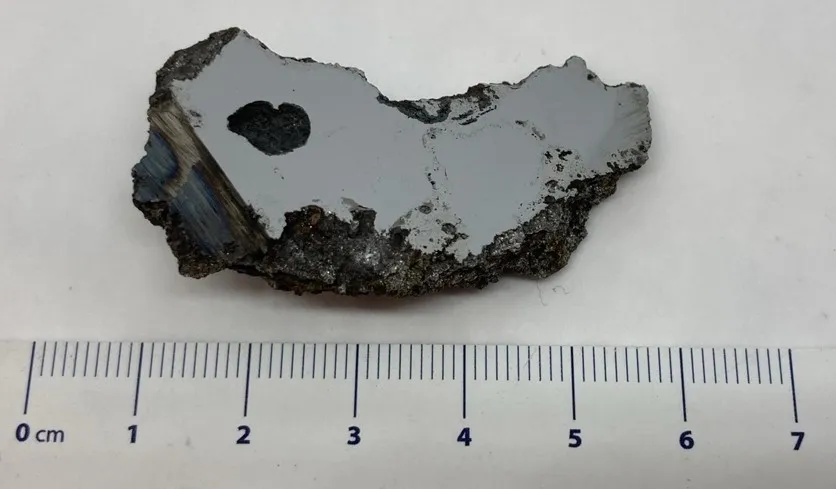Skip to comments.
Two minerals never before been seen on Earth found inside 17-ton meteorite
.livescience.com ^
| 11/28/2022
| By Ben Turner
Posted on 11/28/2022 3:36:36 PM PST by BenLurkin
he two brand new minerals were found inside a single 2.5 ounce (70 gram) slice taken from the 16.5 ton (15 metric tons) El Ali meteorite, which crashed to Earth in 2020. Scientists named the minerals elaliite after the meteor and elkinstantonite after Lindy Elkins-Tanton(opens in new tab), the managing director of the Arizona State University Interplanetary Initiative...
The researchers classified El Ali as an Iron IAB complex meteorite, a type made of meteoric iron flecked with tiny chunks of silicates. While investigating the meteorite slice, details of the new minerals caught the scientists' attention. By comparing the minerals with versions of them that had been previously synthesized in a lab, they were able to rapidly identify them as newly recorded in nature.
The researchers plan to investigate the meteorites further in order to understand the conditions under which their parent asteroid formed.
The team is also looking into material science applications of the minerals.
(Excerpt) Read more at livescience.com ...
TOPICS: Astronomy; Science
KEYWORDS: asteroid; asteroids; astronomy; elaliite; elkinstantonite; geology; hh2; kryptonite; ludditesonfr; meteor; meteorite; meteorites; meteors; minerals; science; tylium
Navigation: use the links below to view more comments.
first previous 1-20, 21-29 last
To: BenLurkin
21
posted on
11/28/2022 6:47:53 PM PST
by
familyop
("For they that sleep with dogs, shall rise with fleas" (John Webster, "The White Devil" 1612).)
To: ctdonath2
Seems to be here:
Somalia Crater If this link works, the white dot is where the meteorite was found. The red dot is a different meteorite found 90 some years ago.
22
posted on
11/28/2022 7:32:27 PM PST
by
Tellurian
(Your phone is your cattle tag.)
To: BenLurkin
sell it to Gucci and make really rare purse latches with it.
or sell it to Xi so they can make fertility powder out of it.
23
posted on
11/28/2022 7:41:55 PM PST
by
griffin
(When you have to shoot, SHOOT; don't talk. -Tuco)
To: goldbux; Chode; SkyDancer; Salamander; Carriage Hill; Lockbox; MtnClimber; nascarnation; ...
Research has led to the discovery of the heaviest element yet known to science.
The new element, Governmentium (Gv), has one neutron, 25 assistant neutrons, 88 deputy neutrons, and 198 assistant deputy neutrons, giving it an atomic mass of 312.
These 312 particles are held together by forces called morons, which are surrounded by vast quantities of lepton-like particles called peons.
Since Governmentium has no electrons, it is inert; however, it can be detected because it impedes every reaction with which it comes into contact.
A minute amount of Governmentium can cause a reaction that would normally take less than a second to take from four days to four years to complete.
Governmentium has a normal half-life of 2- to 6 years; it does not decay, but instead undergoes a reorganization in which a portion of the assistant neutrons and deputy neutrons exchange places.
In fact, Governmentium’s mass will actually increase over time, since each reorganization will cause more morons to become neutrons, forming isodopes.
This characteristic of moron promotion leads some scientists to believe that Governmentium is formed whenever morons reach a critical concentration. This hypothetical quantity is referred to as critical morass.
When catalysed with money, Governmentium becomes Administratium, an element that radiates just as much energy as Governmentium since it has half as many peons but twice as many morons.
24
posted on
11/28/2022 7:47:39 PM PST
by
mabarker1
( (Congress- the opposite of PROGRESS!!! A fraud, a hypocrite, a liar. I'm a member of Congress !7)
To: mabarker1
approaching singularity...
25
posted on
11/28/2022 8:11:05 PM PST
by
Chode
(there is no fall back position, there's no rally point, there is no LZ... we're on our own. #FJB)
To: Farmerbob
16 tons is a good size chunk You dig dig 16 tons, and what do you get? Another day older and deeper in debt...
26
posted on
11/29/2022 6:37:49 AM PST
by
GingisK
To: rx
new mineral....means was different that what's been found before
The prof sounds like he is talking to kindergarten students--probably what he has to do with his "diverse" classes these days.
If we had never discovered any minerals then every mineral would be "new" by his definition. ;-)
27
posted on
11/29/2022 6:42:46 AM PST
by
cgbg
(Claiming that laws and regs that limit “hate speech” stop freedom of speech is “hate speech”.)
To: BenLurkin
Fake science site if it believes that meteor hit in 2020
28
posted on
11/29/2022 6:46:22 AM PST
by
AppyPappy
(Biden told Al Roker "America is back". Unfortunately, he meant back to the 1970's)

Two minerals that have never been seen before on Earth have been discovered inside a massive meteorite in Somalia. They could hold important clues to how asteroids form. The two brand new minerals were found inside a single 2.5 ounce (70 gram) slice taken from the 16.5 ton (15 metric tons) El Ali meteorite, which was found in 2020. Scientists named the minerals elaliite after the meteor and elkinstantonite after Lindy Elkins-Tanton(opens in new tab), the managing director of the Arizona State University Interplanetary Initiative and principal investigator of NASA's upcoming Psyche mission, which will send a probe to investigate the mineral-rich Psyche asteroid for evidence of how our solar system's planets formed.
29
posted on
11/29/2022 7:02:12 AM PST
by
deport
Navigation: use the links below to view more comments.
first previous 1-20, 21-29 last
Disclaimer:
Opinions posted on Free Republic are those of the individual
posters and do not necessarily represent the opinion of Free Republic or its
management. All materials posted herein are protected by copyright law and the
exemption for fair use of copyrighted works.
FreeRepublic.com is powered by software copyright 2000-2008 John Robinson
